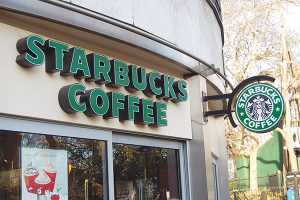Bloomberg
Starbucks Corp. shares pared an earlier loss in late trading after the company released an updated forecast that only projects a slight impact on profits despite a surge in costs related to labor and the ongoing pandemic.
The company now sees earnings per share falling 4% to 6% in its current fiscal year, versus a prior view that it would decline 4% or less. The change to its guidance on operating margin — a gauge of profitability —was also modest. Starbucks reiterated its earlier projection for revenue and comparable-store sales.
“With the cost pressures we’re being proactive,†Chief Executive Officer Kevin Johnson said in a call with analysts following the release of quarterly results. The company will continue increasing menu prices this year, after already hiking them on Oct 1 and Jan 1. It’s also working to automate certain in-store tasks while adding more drive-thru and smaller locations, which have proved to be more cost-effective.
The shares fell less than 1% at 6:09 pm in extended trading in New York. The stock dropped 16% in January, three times the decline of the S&P 500 Index.
Starbucks faces a barrage of higher expenses, including higher-than-anticipated isolation pay and training for workers. The Seattle-based company has already said it’s raising wages this year across the US to $17 an hour on average in a bid to retain employees. And like companies around the world, Starbucks is also fighting off supply-chain disruptions that have added complexity to its operations.
Earnings per share for the company’s fiscal first quarter were 72 cents, after excluding some items. That’s below the estimate of 80 cents compiled by Bloomberg. Operating margin also came in below expectations.
In the report, Johnson noted that inflationary pressure was higher than expected, while adding that demand remained strong. Revenue of nearly $8.1 billion outpaced analysts’ estimate of just under $8 billion. Both the number of transactions and the size in average checks increased in North America.
In China — Starbucks’s other key market — government restrictions and virus resurgences hurt results, with comparable sales declining 14%, compared to an expected 9.3% drop. The company said value-added tax exemptions in China a year earlier trimmed the number by about 4 percentage points. It now has more than 5,500 total stores in the country.
 The Gulf Time Newspaper One of the finest business newspapers in the UAE brought to you by our professional writers and editors.
The Gulf Time Newspaper One of the finest business newspapers in the UAE brought to you by our professional writers and editors.
